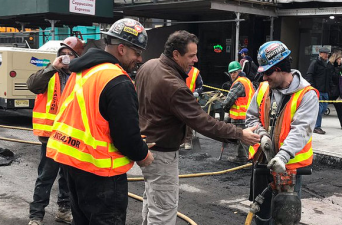How Much Will Fares Rise Without Closing the MTA Capital Plan Gap? Try 25%
When the MTA’s chief financial officer warned last month that the likely price for failing to fund the authority’s capital plan was a 15 percent fare hike, the response was swift. Just 24 hours later, according to Newsday, MTA chief Tom Prendergast “backed away” from that scenario, calling it “unconscionable.”
Evidently the one thing worse than jacking the price of a Metrocard is letting the public know it’s in the works. But if a 15 percent boost would be unconscionable, what should we call a 25 percent increase?
That’s no idle question. I’ve made a careful calculation of the rise in subway and bus fares required to pay for NYC Transit’s share of the unfunded part of the authority’s 2015-2019 capital plan — assuming no other funding source comes along. My result: subway and bus passengers will see their fares go up 25 percent. Monthly unlimited Metrocards will shoot up by $29, nearly a dollar a day. Averaged across every fare medium — 30-day and 7-day unlimiteds, bonus pay-per-rides, and one-ride tickets — the price to ride a bus or train, which now averages $1.92 (taking into account unlimiteds, free transfers, senior discounts, etc.), will rise by 45 to 50 cents.
And that would be on top of the 7-8 percent biennial fare hikes the MTA has programmed indefinitely to cover rising operations costs.
The minimum wage in New York is set to reach $9.00 an hour at the start of 2016 (it’s now $8.75), so the $29 rise in the 30-day unlimited would eat up a half-day’s wages after taxes. In addition to that new burden on millions of low-income New Yorkers, a 25 percent increase in the transit fare would be projected to have these consequences:
- A 3-4 percent drop in subway use;
- A 4 percent deterioration in travel speeds in Manhattan’s Central Business District as some of those dropped subway trips switch to cars;
- Nearly a billion dollars a year in costs from increased pollution, more traffic deaths and injuries, and more time lost sitting in traffic.
Of course, the MTA could avert the 25 percent fare hike by zeroing out the unfunded capital expenditures. But that would slow the uptake of vital upgrades like Communications Based Train Control to a trickle, with even more dire consequences: a 5 percent drop in subway ridership (usage goes down more with spotty service than with high prices), a 7 percent worsening in CBD travel speeds as even more commuters drive, and almost two billion dollars a year in environmental and time costs. And these figures don’t account for the lost farebox revenues that would necessitate their own fare rise.
Going back to the first scenario, in which capital improvements are paid for by a fare hike, here’s how I derived the 25 percent figure:
First, I priced the unfunded subway investments at $850 million a year, a figure tied to the Move NY toll-reform proposal, which earmarks $1 billion a year in net revenue to support the MTA capital plan. I assume that 15 percent goes to the authority’s commuter rail lines, leaving 85 percent, or $850 million a year, for subway improvements.
NYC Transit projects combined bus and subway farebox collections this year of $4.3 billion from record ridership of 2.45 billion trips. Deleting free transfers leaves 2.24 billion paid trips, implying an average fare per paying ride of $1.92. To raise an additional $850 million in farebox revenues, each of those 2.24 billion paying trips would have to cough up an additional $0.38 per ride.
But a fare hike of that magnitude would trigger an estimated 3 percent drop in transit ridership. While that may seem insignificant, the revenue hit across the entire farebox would be on the order of $150 million a year, necessitating another increment to the fare to make back the lost revenue. The total fare hike required to net the $850 million net revenue target turns out to be 47 cents per ride. Weighed against the current per-ride fare of $1.92, the increase is 24.6 percent.
Is bonding a way out? No. The debt must be serviced somehow. Indeed, the $850 million figure represents precisely that: it’s the annual debt service on the capital investment the subways require for modernization, but which Albany still has not funded.
Readers wanting more details may download the current version of my BTA spreadsheet (Excel file) and select Scenario 3 (“Baseline, but Fare Hike pays Subway Cap Invest”) via the pull-down menu in the “Results” tab. The figures in the text will be seen in the “Results,” “Taxes Instead” and “Cost Benefit” tabs.
